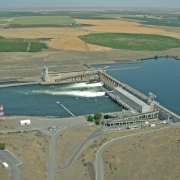Flint Scandal Is Already Changing the Water Utility Business
Utilities respond to lead contamination

By Brett Walton
Circle of Blue
For Carrie Lewis, superintendent of Milwaukee Water Works, the Flint water crisis is a history lesson.
In the spring of 1993, two years before Lewis was hired to oversee the water treatment process in Wisconsin’s largest city, Milwaukee’s water system failed. Cryptosporidium, an intestinal parasite, entered the distribution pipes through the city’s Lake Michigan water intake. The bugs should have been killed by a battery of common purification measures: chlorination, flocculation, filtration. They weren’t.
“Flint will be as transformative for distribution lines as cryptosporidium was for treatment.”
Carrie Lewis, superintendent
Milwaukee Water Works
The mistake resulted in the largest waterborne disease outbreak in United States history, and the consequences were grave. An estimated 403,000 people became ill with diarrhea, nausea, and abdominal cramps, and 69 died. In response, Congress amended the Safe Drinking Water Act to strengthen monitoring and treatment requirements for microbial contaminants. The amendments also ordered utilities to cover reservoirs that store treated drinking water — to minimize exposure to animal feces — and to provide annual water quality reports to customers.
“The outbreak made utilities realize that we are in the business of public health protection,” Lewis told Circle of Blue.
Lewis predicts that similar changes will arise from the Flint scandal.
“Flint will be as transformative for distribution lines as cryptosporidium was for treatment,” she asserted.
The Flint scandal is ripe with lessons: the audacious failure of government, the burdens of race and poverty, the legacy of outdated infrastructure. These hallmarks of Flint will change the utility business in four ways, according to interviews with industry leaders. In the short term, local officials are attempting to avert a loss of confidence in municipal drinking water while making operational changes to avoid lead contamination.
In the long run, utilities are redoubling efforts to educate the public and politicians about the need to invest in the water systems that are the foundation of civic and economic life. Utilities must also implement changes in federal lead regulations, which are now being revised.
A New Way of Doing Business
First, the operational changes. Many cities sent out notices to customers who have lead service lines to remind them of the potential danger. Milwaukee sent letters to 70,000 customers and is receiving 30 to 50 calls per day from customers seeking advice.
“Everybody’s sensitivities are heightened because of Flint,” Lewis noted.
Other responses are still more cautious. Milwaukee has suspended water main replacement work for neighborhoods that have lead service lines, Lewis said.
The water mains are not made of lead, but excavating the street to replace the mains can shake loose lead particles in the service lines that run from the mains to homes. This has been a problem elsewhere. Three Chicago residents sued the city on February 18, alleging that water main replacements caused high lead levels in household tap water.
Milwaukee Water Works, according to Lewis, is developing a protocol for reducing the risk during construction. The outline of the program is taking shape: provide water tanks or bottles to homeowners while the repairs are made, then teach them how to flush their systems of residual lead. After the work is complete, the utility will monitor tap water.
The utility does not have a timeline for resuming water main replacements. It will do so, Lewis said, when she is sure that public health is protected.
Reputation at Risk?
Other cities are reassuring customers that their water is safe.
“All water is local,” said Diane VanDe Hei, the chief executive of the Association of Metropolitan Water Agencies, which represents large utilities. “But what happened in Flint had an impact on water systems in general. People want to know, ‘What is my utility doing differently from what happened there?’”
In the short term, utilities are providing information about water quality testing and the extent of lead service lines. The larger question, one that is a matter of debate, is the long-term effect on the reputation of water utilities. Is the reputation of public water damaged? Pat Mulroy, the former general manager of the Southern Nevada Water Authority, said that Flint was “a black eye” for the water utility industry and that a basic assumption of trust had been broken.
George Hawkins, the general manager of D.C. Water in the nation’s capital, called what happened in Flint “the stuff of nightmares” for those who work in the public utility sector. “The District’s drinking water is safe,” Hawkins wrote in an online opinion piece published by The Hill. “We must not compound the Flint crisis with a nationwide loss of confidence in tap water.”
But some industry leaders say that a distinction should be drawn.
“If Flint were my city, it would take a long time to rebuild trust,” VanDe Hei told Circle of Blue. “Is that the same for every city? I don’t think so. I don’t see a permanent scar.” Her advice to utilities: be honest with their communities and address their worries.
Other utility leaders have not confronted much concern. Martin Querin, assistant public works director for water in Vallejo, California, has been making public presentations in recent months to explain the need for a water rate increase. Querin said that in more than a dozen public meetings only one person had asked about Flint.
“It hasn’t appeared to be an issue with our customers,” Querin told Circle of Blue.
Investment
Querin draws a different lesson from Flint. He sees a fractured relationship between water utilities and their customers — water systems are physically breaking down, but utility leaders are unable or unwilling to communicate that need.
“The black mark is not just because of Flint,” Querin said, referencing Mulroy’s comment. “It’s because water utilities do a poor job in general in communicating with their customers.”
“It’s partly political,” he explained, noting that water rate increases usually must be approved by city councils. “Customers want inexpensive water. Elected people know this. The utility is trained to reduce its requests for rate increases because it knows that it is not going to get the larger sum. Politicians rely on the fact that we have infrastructure that lasts 50 to 100 years. No one tells the customer, ‘Do you want low rates or sustainable, reliable water? What do you prefer?’”
Querin prefers investment. He helped pass a doubling of Fresno’s water rates over five years when he was the water division manager at that city. In Vallejo, he is now advocating for a 73 percent increase in residential bills over four years, to replace old pipes.
The need for investment is one of the lessons that the U.S. Conference of Mayors has taken from the Flint crisis. In its Compact for a Better America, the conference asks Congress to spend more on infrastructure, including water and sewer systems.
New Federal Regulation Forthcoming
To reduce lead in drinking water and to repair broken water systems is no easy task. The utility-customer relationship must be strong. The money must be corralled from ratepayers, state funds, and federal coffers.
New federal lead regulations might play a role. The U.S. Environmental Protection Agency is revising the Lead and Copper Rule, which dictates what utilities must do to minimize lead contamination and how much they are required to tell their customers. A draft rule is expected next year.
A federal advisory council recommended that all lead service lines be replaced. More than 7 million such lines are still in use in the United States. Environmental health advocates want more accountability and public education requirements that go beyond the rather technical annual reports that were mandated as part of the 1996 Safe Drinking Water Act amendments.
It is a familiar spot for Lewis, who sees the need for yet another national readjustment in the wake of an eye-opening crisis.
“The regulatory structure needs to be revamped,” she said. “State, federal — every aspect of water treatment needs to be looked at differently.”
Brett writes about agriculture, energy, infrastructure, and the politics and economics of water in the United States. He also writes the Federal Water Tap, Circle of Blue’s weekly digest of U.S. government water news. He is the winner of two Society of Environmental Journalists reporting awards, one of the top honors in American environmental journalism: first place for explanatory reporting for a series on septic system pollution in the United States(2016) and third place for beat reporting in a small market (2014). He received the Sierra Club’s Distinguished Service Award in 2018. Brett lives in Seattle, where he hikes the mountains and bakes pies. Contact Brett Walton













Leave a Reply
Want to join the discussion?Feel free to contribute!